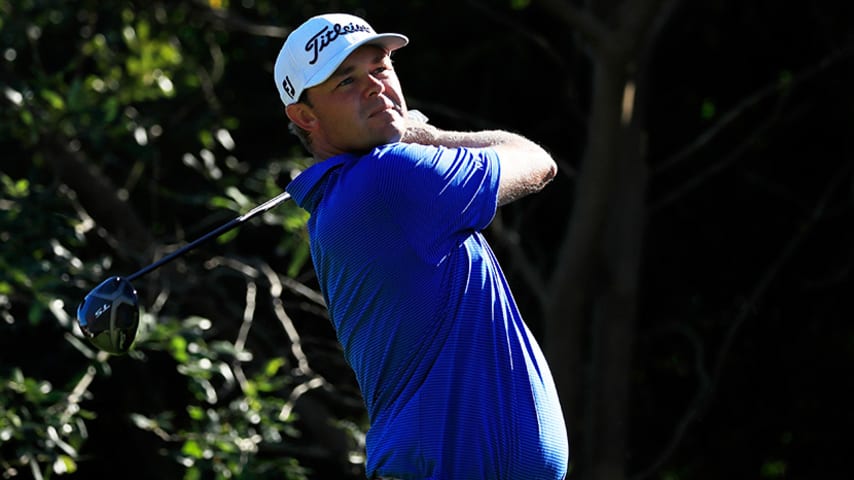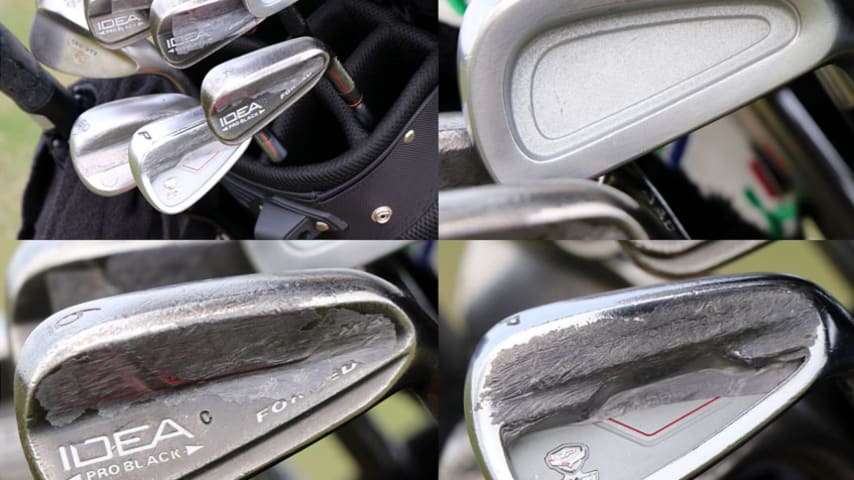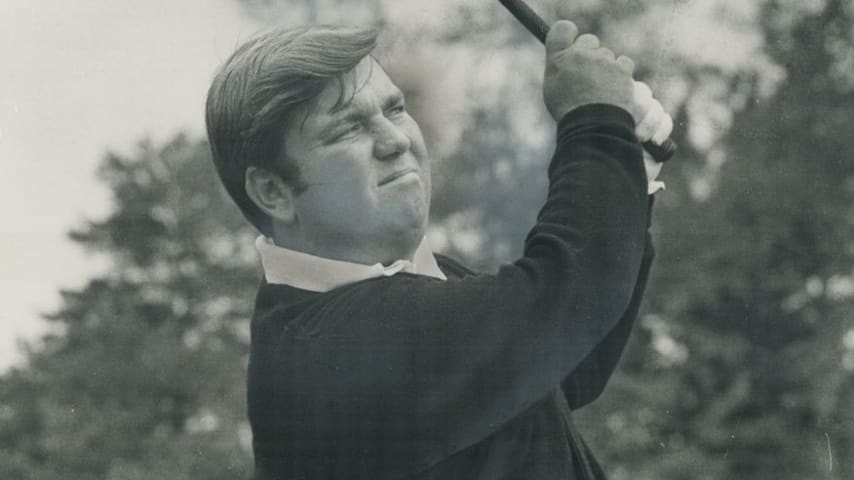Q&A: Titleist's Van Wezenbeeck discusses Kizzire, Harman
14 Min Read

PLAYA DEL CARMEN, MEXICO - NOVEMBER 10: Patton Kizzire of the United States plays his shot from the 18th tee during the third round of the Mayakoba Golf Classic at El Camaleon Mayakoba Golf Course on November 10, 2018 in Playa del Carmen, Mexico. (Photo by Cliff Hawkins/Getty Images)
One is a 5-foot-7-inch lefty, and the other is a 6-foot-5-inch righty, but they both play a bag full of Titleist equipment (here's what's in their bags). To get a closer look at the equipment setups of 2018 QBE Shootout champions Brian Harman and Patton Kizzire, I caught up with Titleist Tour rep JJ Van Wezenbeeck.
Here is the full Q&A.
Question: With Harman being a shorter-in-height lefty, and Patton being a tall righty, there’s a lot of differences there in their games. What are their differences or similarities in how they go about actually testing golf clubs?
Van Wezenbeeck: They’re both pretty different in how they test. Brian knows his launch condition numbers with all of his clubs probably as good as anybody. He spends a lot of time hitting on a launch monitor and really knows his numbers inside and out. So when he’s testing, he’s very aware of ball speeds, launch conditions, things like that. Where, Patton is very much more, ‘I’m gonna swing and can you make things just fly better for me? And when you guys look at the numbers, if it’s better then it’s better.’
The place they’re similar is they both have a good feel for what they like. When Patton’s testing driver shafts, he’s very aware of how that feels, how that loads, how that comes off the face, where Brian is the same thing with driver shafts. We might find one that has good numbers, but if it isn’t loading and feels right for him, then he knows he’s not going to be able to hit the shots he wants on the golf course.
Is that tough for you as a fitter, dealing with the different personalities and different plans of attack for each player?
It’s one of the benefits of having relationships with these players. Brian and I first met when he was transitioning onto the Titleist staff. Sometimes there’s that little get-to-know-you period. But someone like Patton, we’ve been working together since his days on the Web.com Tour, so when you have that history with a player, you can remember a shaft that they played five, six, seven years ago, and you always have that in your internal database, as well as us keeping track of those types of things that allows us to reference those and know where that players likes to live.
This is kind of an interesting scenario with them both being such opposite players, it’s kind of like the yin and yang, a problem that a lot of consumers deal with. Can you talk about how the specs differ, the lie angles and swing weights between a player who’s short and a player who’s tall?
It’s kind of interesting when you look at their setups. We take Patton, he has three drivers actually, a half-inch short. It’s 44.5 inches. It has a mid-70’s weight shaft in it. When you look at Brian Harman, he plays a shaft in his driver that’s closer to 55 grams and plays it slightly long. He’s one who’s looking for a little lighter weight there, and is trying to create speed, whereas Patton, being a big tall guy, we’re trying to hone in the direction for him and the centeredness of the hit. Then as we get into irons, Harman’s are slightly short and Patton’s three quarters of an inch long. It doesn’t always correlate as ‘well I play my irons long so my driver should be long,’ or ‘I play my irons short so my driver should be short.’
How can the general consumer determine whether they should be playing a shorter driver, longer driver, shorter irons, longer irons, etc.?
That’s one of the great things with Titleist is that we have such a good fitting network. Obviously someone like Patton and Brian both have access to our Titleist Performance Institute, as well as our reps out on TOUR, and our Tour van, where we can really make they’re dialed into their correct length where we’re getting a center strike and we’re getting consistent ball flight. But the biggest thing you’re going to want to do is spend time with a fitter where they can look at the way you swing, how you deliver the club, how that shaft reacts with that head, and get you the right length, setting or lie angle.
Now what about the differences in wedge grinds between the two players. I think they both have 4 wedges in their bag. How do you go about getting those wedge grinds dialed in and how are they different?
We’re very lucky because we have Bob Vokey and Aaron Dill. So we have two of the most brilliant minds in wedges on our staff. Aaron Dill is out every week. So somebody like Brian Harman was very set in what he wanted, so Aaron and him spent a lot of time hand polishing parts to get it to react for Brian on very specific shots. Where somebody like Patton, Aaron spent more time with him this fall coming up with kind of a signature for him for his lob wedge.
I think Patton’s using X100’s and Brian’s using S400’s. What goes into that, and what are the differences between the two shafts.
Brian uses S-threes (S300) in his irons. They’re both similar profiles, they’re just different flexes. An X1 (X100) is obviously a stiffer version of that S3. They’re both iron shafts that have been around a long time, and both players have used that particular shaft for a long time, so it becomes a shaft that they know. So it’s as much about a spin/feel scenario as to why Patton’s in X1’s and Brian’s in S3’s.
So I just learned that they’re both playing the new 2019 prototype Pro V1, Pro V1x golf balls. Can you talk a little bit about the backstory of them switching into the new golf balls and what they like about them?
Yea, a part of the interest here too is that they’re different with Patton in the X (2019 Pro V1x) and Brian in the V (2019 Pro V1). They were able to spend some time as we rolled those golf balls out in Vegas. Both of them being Sea Island guys, with a Tour fitter in Sea Island, I think they both saw some improvements with ball speed and still a lot of the great control and feel. Again, they’re both very much, from a fitting standpoint, Brian is going to spend a lot of time looking at his numbers and making sure that the ball is launching appropriately and spinning appropriately. Where Patton is going to be looking up into his windows and just saying, ‘Hey is that flying how I want?’ So they both saw great reactions greenside, but also were seeing some great speed. So it became an easy transition for both of them.
Now I think a lot of golfers are still a bit confused about the difference between V1 and V1x. Can you go through exactly what those differences are and how someone can know which golf ball is right for them?
Yeah, so when we do golf ball work with players, we’re always working from the green backwards. We really think wedge, short game, as well as your irons are the most important thing when fitting a golf ball. We’re able to do so many adjustments with our TS drivers that we can make the driver go slightly higher, slightly lower if we need to for the golf ball. So Patton’s a player that’s often trying to add some spin and height to his game, which is a perfect example of why he’s in the X ball, because it’s a little higher-flying golf ball. Where Brian is often trying to control his spins and flight his irons a little more, so the V1 is the perfect product for him.
So let’s get into each player a little more specifically … so I know that Patton, he is in the new TS3 driver, right?
Correct.
What was the process like getting him fitted into the new stick, and I know you said he’s in tune with his shafts, what was that shaft testing process like in the new head?
A two-parter with Patton is, he was exposed to the TS when it was truly in its prototype phase before we had brought it out, and he saw some really good ball speed increases. So by the time that we rolled it out at the U.S. Open, he was already clamoring for the product. Originally, we went with the same shaft that he had previously been using. As we progressed through the summer, we saw an opportunity for him to maybe even tighten up his driving a little bit more as he was making some swing changes. So, anytime we’re working as part of a team, anytime a player is making swing changes, we are involved in the process and making sure that their equipment is matching that. So we were able to look at his driver shaft length, as well as different profiles and ended up in a Fujikura 757 TR.
What’s different about that TR compared to other Speeder 757s, or other Speeders that general consumers are used to?
So this one is a lot firmer through the midsection than what he had been using in the past. We’re able to keep the loft up in the TS3 10.5, and then firm up the shaft to kind of control some of the spins. We are able to keep the launch up and keep the spin under control. It also allowed more of one-direction shape for Patton, rather than having, we had a little bit of a two-way miss prior.
Going down into the irons, he has a pretty mixed bag. How does he, or a TOUR player, determine gapping and where those cut-off points are between the different iron models?
So this is part of our fitting process with all of our players. It gets difficult in gapping sometimes as we work with TOUR players because they hit their driver so far that they still only get to play with 14 clubs like you and I do, so the big key is looking at where we want help, and where we need to spread things out. So, for someone like Patton who’s playing four Vokey wedges, we’re going to work off that, because he wants all that help in the scoring zone. As we’re progressing through his bag is where we’re having to stretch gaps out as we get higher in his bag. But we also want to make sure we’re keeping heights up. So if he has a 4-iron into a green, it’s still going to have some stopping power. That’s why we progress from an MB in a short iron, to a CB in a mid-iron for Patton. It allows us to have a little bit better of a vertical window. And then as we’re progressing from his irons to his hybrid, the T-MB not only gives us some height but gives us some ball speed. So that helps push that gap from his 4 to 5 iron.
How can someone know that they’re the right golfer that should be getting into a mixed set?
You have to look at the peak heights and how launch and spin and speed relate to creating that peak height. So as we’re progressing a player through their bag, they might have problems with their 2 iron, or 3 iron or 4 iron. You look someone like Patton where we’re starting to see a chance for improvement starting at the 6 iron. So I think a lot of consumers can really work with a fitter and spend time looking at their whole bag rather than just walking in and saying ‘I’m just going to get a three through pitch and go play golf.’ That top end of the bag is really a big area where a lot of amateur golfers can see improvement through some fitting.
General theme here being ‘get fit.’ So moving onto Harman a bit, I think he’s yet to switch into a new TS driver, right? He still has the 917D2?
Yes, he went back to the 917D2.
Is that a case of him kind of just being stubborn, or are you guys working on getting a new driver into play and it just needs more testing or what’s that process there with him?
Again, Brian has a lot of, we have to do numbers and feel at the same time. He has a very, very consistent ball flight. We’ve had some tests where we’ve seen some really good ball speeds with him with TS, and it’s really more just getting some time. These guys schedules are very full with golf and life, so this is something we’ll work throughout December with him, where he can get some time away from tournament golf to test further.
Is that tougher now that he just got a win? Where he’s like, “Well, I just won, maybe I shouldn’t change.”
He’s seeing good ball speeds with TS, so there’s not many guys that want to leave yardage behind. So, obviously you’re feeling good about everything when you get a win, but you always want to get that little bit better.
I notice he has two 3-woods in the bag; one is 13.5 and the other is 15. But, the 13.5 is a TS and the 15 is a 917, is that right?
I didn’t hear back from Brian to know if that ones right from Darrell, because normally he plays a 3-wood, 5-wood. A big thing for him on the TS 3-wood is he saw a big jump in distance and that becomes a big advantage club for him to have. So I was trying to ask Brian, and sorry I didn’t get an answer quite yet, was if that loft on that 917 is correct, if that was his 18-degree 5-wood that was just mismarked (on Darrell).
It’s kind of interesting that he has a new fairway wood in the bag being that it seems like for most guys that’s the last club to change. Is there something special about the TS that he noticed?
The big thing was ball speed. We tested it in Akron this summer and he immediately saw ball speed. It’s always a tough one with 3-woods because sometimes that go a little too far for guys, but the TS2 launched really well for him. So when he saw the launch go up like it did, and the ball speed go up, it kind of became a club on par fives that he could potentially be getting home now where he wasn’t going to be able to before. So that was the big thing he saw when he testing the TS in a fairway.
I think there was a bit of discrepancy online, or on social media or whatever the case may be. Did he have a hybrid in play or did he have a long iron? Do you know?
Unfortunately I think they may have been enjoying their win this morning where I hadn’t heard from Brian to confirm. Typically, and this goes back to our fitting, he would play a CB 3 iron that we had bent weak, and then go to a CB 5 iron, so he wouldn’t carry a 4. We would have his 3 iron be kind of a 3/4 iron. This summer he was looking for a bit more height out of that, and he switched to an 818 hybrid. So those clubs kind of went in and out depending on golf course.
Last question. I know Harman is still playing a Taylor Spider (OS CB) putter, but he was playing a Scotty before, and it seems like he kind of bounces back and forth. Does he do a lot of putter testing, and are you guys making a bunch of prototypes for him?
He had a few different prototypes. Obviously hitting from that side of the golf ball. There’s a few less models so they’re having to make some custom stuff for him. Again he’s a very feel-oriented person, so he’s definitely very involved with Scotty and the team, and talking about things he likes to see and feel, and working Scotty and Paul Vizanko, and Johnny and Drew our putter reps, and kind of giving them feedback. You putting is such a fickle thing for all golfers that sometimes you want to go back to a putter you know, but you’re always trying to putt better and those guys are always working on a few things for him.






